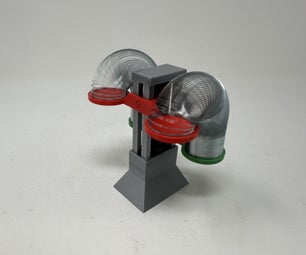Introduction: Introduction to Chainmaille
Have you ever started knitting a sweater and thought, "I wish this had better protection against arrows?" You may want to consider putting down your knitting needles for a pair of pliers and start making some chainmaille.*
Chainmaille is a strong yet flexible metallic fabric constructed from rings. Though I would strongly recommend against relying on it to block a sword or arrow, chainmaille armor can be constructed for such uses. Today, chainmaille is used for a variety of purposes. The most obvious is probably reenactments and Live Action Role Playing (LARPing). However, one can also find chainmaille used for several uses: from armor against sharks to attractive jewelry. If nothing else, maybe you just want a nice hobby with a tangible product.
Actually making chainmaille can be a fun and relaxing task; though it may seem slow, at times. I started making chainmaille about eight years ago out of curiosity. In that time, I have started and completed several projects: including several bracelets and necklaces, a pair of gloves, a coif (headgear), a couple bags, and much of a shirt.
For this introduction, I will describe how to make chainmaille starting from rings. Specifically, I will describe how to make 4 in 1 European pattern: a fairly basic but useful pattern.
*EDIT: As it has been (reasonably) pointed out, chainmaille is NOT good protection against piercing blows, such as arrows. Regardless, I ask that you please, PLEASE, do not run a "will this kill me" test. Especially in an amateur setting.
Step 1: Gather Supplies
You will only need a few supplies for this project:
- Metal rings
- Needle-nose pliers
- Towel (optional)
If you are having trouble choosing metal rings, I generally use rings made from 16 AWG galvanized wire with an internal diameter of 1/4". I find this a good aspect ratio for this pattern (i.e., the ratio between the diameter of the ring and and diameter of the wire). Galvanized wire is strong and rust-resistant, though I have found that it can lose its shine over time.
You also may want to consider making your own rings.
Step 2: What We Will Do and Some Conventions
I will be describing how to make 4 in 1 European pattern. This is a very simple, yet useful pattern. The “4 in 1” just means that each ring is connected to four others (except on the edge). Similarly, you can have an “even number” (except 2, which would be a chain!) “in 1” European pattern.
Throughout this project, you may want to place a towel under your work to collect pieces of metal.
For this purpose, all rings in the pattern will be “tilted” along a horizontal axis. “Tilted down” means that the far side of the ring is lower while “tilted up” means that the far side of the ring is higher.
Step 3: Prepare the First Rings
Close four rings with pliers.
Open a fifth ring (so a single squeeze with the pliers closes it).
Step 4: Things Are Coming Together
Place four closed rings in the open ring and close it.
Orient rings so the previously open ring is tilted down, and two closed rings are tilted up on the left and right.
Step 5: Add Rings Horizontally
Make another open ring and two closed rings.
Attach open ring through the two rings on the right tilted down.
Feed the two closed rings through the open one on the right tilted up.
Close the open ring.
Step 6: Add Rings Vertically
Make another open ring and two closed rings.
Attach open ring to the top two tilted up rings on the left.
Feed the two closed rings (tilted up) through the open one: above the ring on the left and right.
Close the open ring
Step 7: Finish the Row and Beyond...
Note the top right corner appears missing; let’s fill that up.
Make one open and one closed ring.
Feed the open ring through the three “tilted up” rings that make up the corner.
Attach the closed ring (tilted up) on the upper left.
Close the open ring
Add more horizontal and vertical row
Step 8: Conclusion
From this pattern and variants on it, you can make most patterns. Do not be afraid to experiment: try adding more rings (or fewer) in places, try connecting the edges of your sheet into a loop, etc. If you have colored rings, you can even make some pretty cool patterns. Need some inspiration? Check out some of my projects (image).

Participated in the
Hand Tools Only Contest 2016










